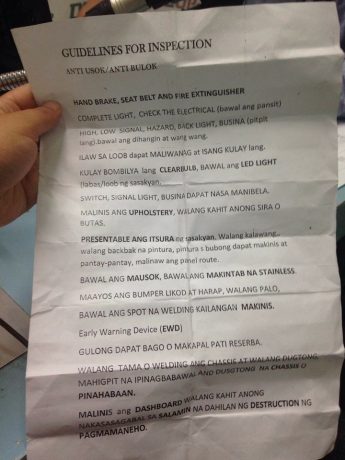Opposition and left-leaning “activists” are up in arms over a photo of what is said to be a list of requirements jeepney drivers need to meet in order to comply with government efforts to improve the quality of public transport and air quality in major Philippine cities.
Jeepneys are 1940s-vintage design vehicles and remain a primary means of public transport in the Philippines. Many of these are cobbled together from reconditioned used and surplus parts and, as such, will likely not comply with even the most basic globally-accepted roadworthiness standards for motor vehicles.

The purported list included, among other things, requirements that seat belts, fire extinguishers, and hand brakes to be installed and that all external lights and indicator lamps are functional — including switching of low and high beams for headlights. Still other requirements were seemingly meant to ensure vehicles were generally presentable and laid out for utility — possibly to reduce the garishness in design jeepneys have long been infamous for. A particularly important requirement spelt out in the list is that the chassis should show no evidence of being welded together or extended in length. This is important considering that the chassis is the structural backbone of any motor vehicle and the single biggest factor that contributes to vehicle handling, stability, and safety.
All of the above come across as pretty reasonable requirements specially considering that these are requirements for public utility vehicles where safety is of paramount importance. Yet Opposition “activists” are claiming that these requirements put a serious burden on “poor” jeepney drivers who depend on the current clunky vehicles for their livelihoods. This is essentially asking that a lower-standard set of requirements be applied to “poor” vehicle owners and operators and that world-classstandards be applied only to more affluent motorists. This is ludicrous, to say the least.
It seems that it didn’t occur to these people that the public also depend on safe public transport for their livelihoods. Government vehicles and, specially, public utility vehicles should serve as models that the private sector could be held to. In the Philippines, at present, it is the other way around in the usual Bizarro way the country operates. Government and public utility vehicles are often the first to violate safety and roadworthiness standards while many safety initiatives are led by private sector proponents.
The reason the poor continue to think like poor people is because of “activists” who insist that they be subject to mere pwede-na-yan standards and not the excellent world-class standards that truly prosperous people aspire to meet. The jeepney problem has long ago passed any opportunity to be phased out in the softly-softly manner so-called “pro-poor” partisans espouse. Metro Manila is in crisis situation and, like a tooth that had been allowed to abscess and is causing intolerable pain, jeepneys should be pulled out unceremoniously and tossed into history’s crapper. Perhaps if Filipinos had not sat on the problem for decades and allowed it to fester to the monstrous proportions seen today, the jeepney problem could have been solved more “humanely”. Unfortunately, we are at a point where it just simply needs to be put out of its misery.

No comments:
Post a Comment